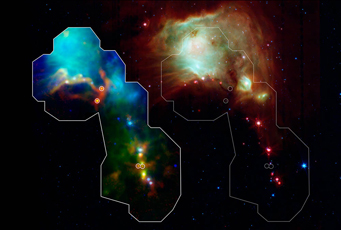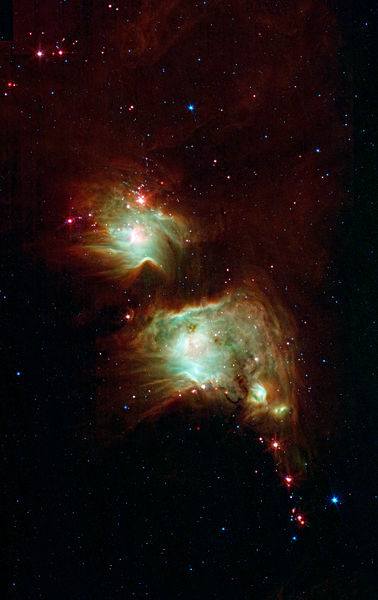The Herschel Space Telescope, now approaching its final days, has helped astronomers spot one of the earliest stages of star formation.
Astronomers have found stars in the earliest stage of formation 1,600 light-years away, inside the bright nebulae of the Orion constellation, reports a recent study published in the Astrophysical Journal.

The ready-to-retire Herschel Space Telescope has found newborn stars swaddled in dust within the Orion Molecular Cloud's vast stellar nursery. The protostars represent some of the youngest ever observed.
NASA / ESA / ESO / JPL-Caltech / A. Stutz (MPIA)
The discovery came as part of the Herschel Orion Protostar Survey. HOPS is studying hundreds of forming stars at multiple wavelengths with the aim of following stars from their infancy to adulthood.
Astronomers know that protostars begin their lives as dense clumps of gas. Not yet dense enough to shine by fusing hydrogen, protostellar cores glow from the heat of gravitational collapse. The Spitzer Space Telescope spots the infrared light emitted by older, hotter protostars and had already identified several before the Herschel Space Telescope took a look. Herschel, which is running low on coolant these days, observes at even longer far-infrared and sub-millimetre wavelengths, so the instrument is ideal for finding protostars’ faint younger siblings.
Still, it was happenstance that led the HOPS team to the elusive baby stars, says Tom Megeath (University of Toledo), the HOPS project leader. He was confirming Herschel detections of Spitzer-discovered protostars when he saw something unexpected.
“In the first Herschel image I looked at, sure enough, there was the protostar – but there was another object right next to it,” Megeath explains. “That second object hadn't shown up in the shorter-wavelength images taken with the Spitzer telescope.”

Many of the protostars were found in M78, a bright reflection nebula in the Orion constellation, imaged here by the Spitzer Space Telescope. Herschel observations caught 11 young protostars missed by Spitzer due to their cooler temperatures.
NASA / JPL-Caltech
HOPS observations turned up 55 new candidate protostars, which were either very faint or undetected in the Spitzer survey. The team analyzed the objects to confirm they were actually protostars instead of, say, distant galaxies, which can mimic a protostar’s faint, red appearance.
Of these, the team claims 11 candidates can be reliably identified as extremely young protostars in the very earliest stage of formation, known as Class 0. Combining Herschel and Spitzer data, the team finds an additional 7 sources that were previously known, bringing the total number of newborn stars in the area up to 18. These protostars are swaddled in some of the densest gas envelopes found in Orion, says the team, so they’re probably accreting gas very quickly.
The newborn stage of stellar infancy lasts just 25,000 years, says Amelia Stutz (Max Planck Institute for Astronomy, Germany), the study’s lead author. That’s a blink of the eye in cosmic terms. Her team arrived at this estimate by counting up the stars in the area and comparing the number of new protostars to those that are more evolved. For comparison, a fully formed “adult” star lives roughly 10 billion years.
These findings might help astronomers learn more about the mysterious, enshrouded phase of star formation. “We don’t know exactly what the conditions in such star-forming cores are like, or how those conditions influence the forming star,” Stutz says.
As Herschel’s imminent shutdown approaches, the team is squeezing in some follow-up observations to look at the protostars in more detail. Even after Herschel’s coolant runs out and the instrument goes into hibernation, Stutz hopes to continue using other long-wavelength facilities, such as the Institute for Radio Astronomy in the Millimeter Range (IRAM) and Atacama Large Millimeter/submillimeter Array (ALMA).
“Further observations and detailed studies will reveal key aspects of these very young sources,” Stutz says.
Guest blogger Phil Unsworth studied astrophysics at the University Of Hertfordshire before writing for Astronomy Now. He was born in and still lives near Sheffield, England.
 12
12
Comments
Mike W. Herberich
April 10, 2013 at 9:56 am
Question: so, are these 25'000 years of newborn infany to be thought of as BEFORE the fusion ignites, that is, more or less the actual time the gravitational collapse is happening? Or is it to be thought of as the first 25'000 years AFTER fusion began?
You must be logged in to post a comment.
Bruce
April 10, 2013 at 6:31 pm
That is a good question Mike. My guess is that this is the pre-fusion accretion period, but I'd like confirmation too.
You must be logged in to post a comment.
Peter
April 10, 2013 at 9:39 pm
It would seem the conditions must be millions of years in the making. After some tipping-point is crossed, then it only takes 25,000 years for fusion to begin?
You must be logged in to post a comment.
Lou
April 11, 2013 at 5:53 am
These are the very youngest protostars - they have a long, long way to go to reach the fusion stage (Class 0 is the first stage, fusion is the last stage).
You must be logged in to post a comment.
Mike W. Herberich
April 11, 2013 at 9:39 am
I still don't get it: what is this (approximate) period of 25'000 years from the article getting at, or alluding to? The states are: dense clumps --> gravitational collapse --> fusion ignites --> life as star begins. Where exactly is the birth to be positioned, and where the 25'000 years? I'd assume that birth is equal to fusion igniting, is it? I read and heard that the collapse itself happens within milliseconds which makes it unlikely to be compared to 25'000 years. That leaves the duration of accretion into dense clumps ... or the first 25'000 years after fusion began. Both seems controversial to me.
You must be logged in to post a comment.
Bruce
April 11, 2013 at 11:56 am
The Wikipedia article on Protostars confirms what Lou wrote about T0 being the earliest part of the accretion phase. Mike, you must be confusing what happens to very massive stars at the end of their lifetimes when core collapse can occur in milliseconds.
You must be logged in to post a comment.
Mike W. Herberich
April 12, 2013 at 9:24 am
Okay, that figures, Bruce. That's what I was thinking of and obviously confusing with what we're concerned here. So, these 25'000 years are supposed to be the last phase (of accreting/ gravitational compacting) before fusion starts?
You must be logged in to post a comment.
Bruce
April 12, 2013 at 8:55 pm
No Mike, T0 is not the last part of accretion, it’s the first, when dust clumps warm up enough to radiate in submillimeter wavelengths. The next stages are TI, TII, and TIII, in which protostars radiate in far-infrared, near-infrared and visible light respectively. These are really just warmer and warmer temperature ranges observed in the accretion process. After TIII fusion takes over from accretion as the energy source causing the star to shine. My thanks to Wikipedia and its article on Protostars for helping me understand this. This article includes a small chart labeled “Classes of Protostars” that is very helpful.
You must be logged in to post a comment.
Mike W. Herberich
April 15, 2013 at 8:59 am
I see-saw: I saw (the article), now I see. It took an extra accretion phase for my brains (to collapse? Or to commence fusion?). What surprised me was that a 1 solar mass protostar takes only approximately 100'000 years to begin fusion. I would rather have expected something like millions of years.
You must be logged in to post a comment.
Bruce
April 16, 2013 at 7:20 am
Yes Mike, that’s an excellent observation. 100,000 years is like no time at all in universal terms. It’s less than one 7 millionth of universal time! Our universe is a marvelous star (and planet!) producer, is it not? It’s like a vast machine running a program (the laws of physics) on raw material (energy) to prodigiously crank out star systems. And consider this, if the rate of star formation was much different than it is, would we even be here? Certainly not at this point in universal history, I would think. Whatever one believes as to causation, we should be able to “see” that protostellar formation duration is one of the numerous consequences of the laws of physics that have made our lives possible.
You must be logged in to post a comment.
Mike W. Herberich
April 16, 2013 at 9:56 am
Oh so true, Bruce. When put into perspective with your "regular", "ordinary" life span of a star instead of with the entire duration of the universe so far, the story does not look much different, does it? Comparing 100'000 years to 13.7 billion vs. to 10 billion, our sun's life time, is pretty much of the same order. I only came to think of that reading your post. I've never actually realized that our own sun almost covers the duration of the universe itself! Pretty amazing: 2 such life spans stringed together in sequence would surpass the duration of the entire universe: wow!
You must be logged in to post a comment.
Bruce
April 18, 2013 at 11:31 am
That’s interesting Mike. It makes me think of beginnings, and how long they can last. Since evidence leads to the conclusion that our sun and solar system are about 4.6 or so billion years old then there would have been about 9 billion years of prehistory before our system was even a glimmer in some giant molecular cloud. Since the duration of the proto stellar phase is short, and since massive stars fuse elements quickly, there was plenty of time for several generations of massive stars to have come and gone in this 9 BY period, building up the metal content enough for planets with earth’s elemental abundance to form by the time ours did. I personally believe this picture of the past is correct, but I also believe the Genesis account too. Some object to Gen 1:1 on the grounds that the universe began billions of years before earth’s formation. This objection can be overcome by considering “the beginning” as simply meaning ‘that which came before.’ Verse 2 of Gen 1 picks up at a time when the earth was covered by water. That there was such a time in the earth’s past is consistent with geology, as there is thought to have been a time prior to the formation of earth’s continental landmasses. (If the earth’s solid surface had no relief then water would cover the planet to a depth of 4,000 meters.) If this ‘water world’ period of earth’s history was around 2 or 3 BYA then “the beginning” of Gen. 1:1 could have spanned a period of around 11 billion years.
You must be logged in to post a comment.
You must be logged in to post a comment.